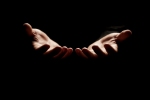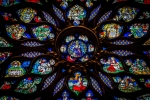November 2012
Liturgy, Music, & Leadership
Collective Prayer
Let Us Pray
I pray. You pray. We pray. We pray one unified prayer, the collect, as we join our hearts, minds and our voices. This one prayer with many voices is like an ocean wave that builds energy from the wind. The multitude of voices, powered by the Holy Spirit, mimics the swelling of the wave until the prayer, like the wave, crests and finally breaks. With its energy released, the prayer rises to God. Imagine the remains of a foamy whitecap when the wave crest breaks and reaches the shoreline of the beach. A wave no more, the calm, foamy water quickly rolls back into the source from whence it came, retreating into itself, yet present. Let us release our prayer for all baptized Christians to God, and may the foamy “whitecap” calm us and remain present with us as we conclude the collect with, “Amen.”
The Collect is a short but powerful prayer because it “collects” the community and God into common spiritual ground. Collective prayer, the simple act of praying together, seems like an ordinary experience for many of us today. Community prayer, however, is a privilege that did not always exist for Black people.
During slavery in the U.S, enslaved blacks did not have the freedom to gather together in worship. They could not be full members or pray freely as a community in some churches. In many places, it was against the law for enslaved people to be taught to read and write.
They could not own a Bible, let alone read it. The inhumane treatment they received at the hands of their enslavers, and the dehumanizing experiences were, in direct contradiction to the Gospel. The word that was preached was twisted to promote the interest of the enslavers.
In spite of this, the Gospel was heard. Black people interpreted the scripture, and prayers they heard for themselves. Scripture became a prophetic and liberating force in lives of hardship and oppression. They took for their own, the story of the Exodus and the Israelites’ escape from bondage.
Daniel in the lion’s den was their story of God protecting the faithful. It was a story of deliverance. Joseph being sold into slavery by his brothers was a familiar story. Many had experienced being sold into slavery by black brothers and sisters.
Jesus embraced the outcasts and broke bread with them. Jesus shared in their suffering when he suffered on the cross. Jesus became their friend, sharing their stripes, humiliations, and troubles. Black people would “steal away” to be with their friend Jesus. They would gather in secret at appointed times and places to pray, preach, sing, lament, celebrate, strengthen, and encourage each other.
They would slip away to remote places at night where they could not been seen, or heard. These times would supply the hope, and endurance they needed to actively resist the enslavement of their spirits as well as their bodies. The singing of the hymn “Steal Away to Jesus” was the signal for the gathering.
An important part of setting the stage for their prayers was what has become known as a Prayer Kettle and kettle prayers. The prayer kettle was a big cauldron or pot that would be placed upside on the ground.
Rocks might be placed under the rim so they could speak into the kettle. Kettle Prayers were the prayers people offered into the pot so they could not be heard in the night. Like the Prayer Book collect, the prayer kettle became a container for all their hopes and dreams collected there, and lifted to God.
Many descendants of enslaved people pass the Prayer Kettle from generation to generation as a touchstone or a cherished and sacred connection to their ancestors. It is a reminder of their suffering, and the comfort, healing, and release they found in prayer together.
It is cherished because it connects them with the past, in a tangible and poignant way. The Prayer Kettle is sacred because it is filled with their prayers and conversations with God. As we gather to say our collect, and other prayers, we stand in that tradition. Now, the house of worship is our Prayer Kettle, its walls are steeped in our prayers.
Today, the prayers we share come from the pages of a book as well as our hearts. In those pages, we read the prayers of many people. We can even write our own. Let us remember the privilege we have to gather in the house of God, and pray together.
Collects are short prayers found throughout the Book of Common Prayer. It is a prayer purposefully constructed to gather our hearts, hopes, and intentions—our collected prayers— into a few words. The shape of the prayer is simple with three ideas.
It begins with something about the nature of God, and describes some way that God is present in the world. For example, “O merciful Creator, your hand is open wide to satisfy the needs of every living creature:” (For Stewardship of Creation, BCP 259). The next words form a request. Collects usually end with the name of God or Jesus and the Holy Spirit.
The prayer leader begins with these words, “The Lord be with you.” These words are a pronouncement (a statement) and a hope. We respond, “And also with you.” With these words we acknowledge, and welcome the marvelous reality that God is present among us. We invite God into our collective prayer.
“Let us pray,” is an invitation that many of us miss. It is not simply an introduction to the next words that the celebrant will say. It is a pregnant moment. There is excitement in gathering. Now is the moment to sit, and breathe in the spirit.
In those moments, after “Let us pray”, comes a settling of the Spirit among us. As we arrive in the sacred space, we carry a variety of concerns, and joys on our hearts, and minds. For example, looking at members of our church, we might observe Toni. She sighs and her children are restless from all their rushing to get there. Maybe now they will settle down.
Marie arranges her sweater, relaxing herself. She too, barely made it on time. She thinks of her mother no longer able to get to church. Yvonne can barely sit still anticipating going off with friends at the end of service to celebrate her engagement, and new job. John is grateful. His ride came, and he is able to be here.
At the back, Bernice paces, looking forward to coffee hour, her meal for the day. She wonders, will there be leftovers this time. Johnnie is in his usual place in his crisp suit. He smiles, and nods but understands little of what is said to him.
There is excitement in church today because there is going to be a baptism. God is at work among the people. The collects used at baptism, stand in a long line of prayers from the past, today’s prayer, and prayers for the future.
The invitation to the Collect of the Day offers an opportunity for each one to ponder their unique cares and concerns. It is a dialogue where we can also offer that which is yet unspoken to God. A collect is also used to designate special occasions, like baptism or seasons of the Church.
When we gather for worship, we come together from many places and experiences. In Holy Baptism we are drawn together to celebrate our initiation and adoption, our sister and brotherhood as Christ’s own in a physical and spiritual body.
We begin this service of Christian initiation in a dialogue framed by the words of the opening acclamation and the dismissal. These words begin a liturgical conversation in sacred moments of prayer, scripture, sacrament and singing. These are all ways we proclaim the blessedness of God and our unity as a people in that blessedness through God.
The marvelous thing about baptism is we are witnesses to a miracle of transformation. We gather as many in Christ, we are united in one Body, one Spirit and one hope. Each time we come together we celebrate Christ.
This bond grows deeper and wider with each baptism, each time we bow our heads in collective prayer and each time we recommit ourselves to aspire to Holy Living, renouncing evil, and sin and turning with our whole heart to Jesus.
We dedicate ourselves to God and each other to be a community that preaches the Gospel and upholds others in their life in Christ. We vow to uphold the dignity of every human and strive— move with our whole being —towards justice and peace. These are strong words but we trust in God’s will to help.
As we gather as community, there is often much excitement in greeting one another, greeting God, anticipating what is to come. But soon it is time to settle down into prayer, to acknowledge God with us.
With the praying of the collect, the mood changes into one of collective reverence. In that silence, we can appreciate having the freedom to gather and pray. In that moment, we connect with all those who have experienced any kind of bondage.
We acknowledge our call to be instruments of peace. We lift our prayers to God.
This article was first published under the title “Collect of the Day” as part of “Stories of Transformation: Worship, Witness, and Work in the Black Community,” a new resource from the Episcopal Church’s Office of Black Ministries and was reprinted by permission.
The Rev. Karen B. Montagno is Director of Congregational Resources and Training (CRT) for the Episcopal Diocese of Massachusetts. CRT equips and supports congregations, lay and ordained ministers in mission, formation and creating vital and viable congregations and communities of faith. Montagno, second vice president of the Union of Black Episcopalians, also serves as priest at St. Cyprian's Church in Roxbury, Massachusetts. She is co-editor of Injustice and the Care of Souls, which addresses issues of injustice in pastoral care with marginalized groups and individuals. As a colleague of the Bethany House of Prayer she joins the Sisters of St. Ann Bethany in their ministry of prayer and hospitality. This ministry involves retreat work, refreshment days and sharing in sacred conversations.
Resources
- Collects of the Church Year
- Kettle Prayer Tradition (from the Christian Broadcasting Network)
- “Stories of Transformation: Worship, Witness, and Work in the Black Community,” a resource from the Episcopal Church’s Office of Black Ministries






